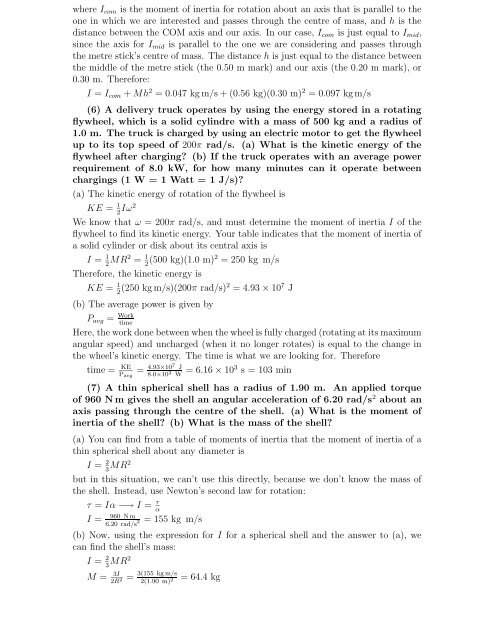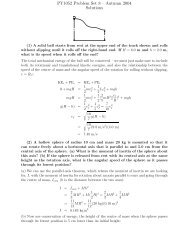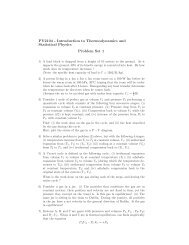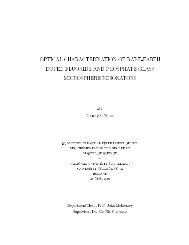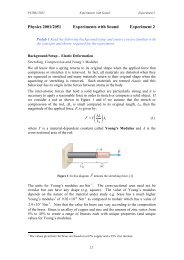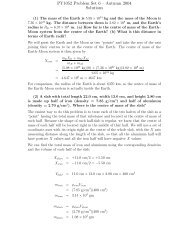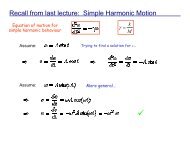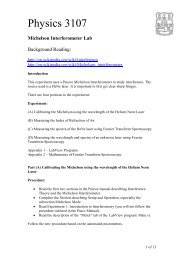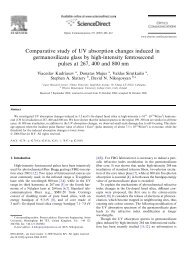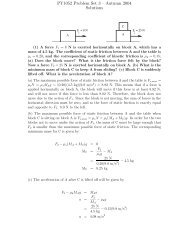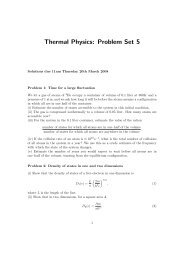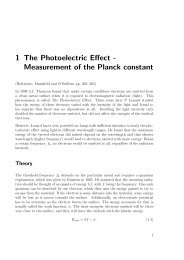PY1052 Problem Set 7 â Autumn 2004 Solutions
PY1052 Problem Set 7 â Autumn 2004 Solutions
PY1052 Problem Set 7 â Autumn 2004 Solutions
Create successful ePaper yourself
Turn your PDF publications into a flip-book with our unique Google optimized e-Paper software.
where I com is the moment of inertia for rotation about an axis that is parallel to theone in which we are interested and passes through the centre of mass, and h is thedistance between the COM axis and our axis. In our case, I com is just equal to I mid ,since the axis for I mid is parallel to the one we are considering and passes throughthe metre stick’s centre of mass. The distance h is just equal to the distance betweenthe middle of the metre stick (the 0.50 m mark) and our axis (the 0.20 m mark), or0.30 m. Therefore:I = I com + Mh 2 = 0.047 kg m/s + (0.56 kg)(0.30 m) 2 = 0.097 kg m/s(6) A delivery truck operates by using the energy stored in a rotatingflywheel, which is a solid cylindre with a mass of 500 kg and a radius of1.0 m. The truck is charged by using an electric motor to get the flywheelup to its top speed of 200π rad/s. (a) What is the kinetic energy of theflywheel after charging? (b) If the truck operates with an average powerrequirement of 8.0 kW, for how many minutes can it operate betweenchargings (1 W = 1 Watt = 1 J/s)?(a) The kinetic energy of rotation of the flywheel isKE = 1 2 Iω2We know that ω = 200π rad/s, and must determine the moment of inertia I of theflywheel to find its kinetic energy. Your table indicates that the moment of inertia ofa solid cylinder or disk about its central axis isI = 1 2 MR2 = 1 2 (500 kg)(1.0 m)2 = 250 kg m/sTherefore, the kinetic energy isKE = 1 2 (250 kg m/s)(200π rad/s)2 = 4.93 × 10 7 J(b) The average power is given byP avg = WorktimeHere, the work done between when the wheel is fully charged (rotating at its maximumangular speed) and uncharged (when it no longer rotates) is equal to the change inthe wheel’s kinetic energy. The time is what we are looking for. Thereforetime = KEP avg= 4.93×107 J8.0×10 3 W = 6.16 × 103 s = 103 min(7) A thin spherical shell has a radius of 1.90 m. An applied torqueof 960 N m gives the shell an angular acceleration of 6.20 rad/s 2 about anaxis passing through the centre of the shell. (a) What is the moment ofinertia of the shell? (b) What is the mass of the shell?(a) You can find from a table of moments of inertia that the moment of inertia of athin spherical shell about any diameter isI = 2 3 MR2but in this situation, we can’t use this directly, because we don’t know the mass ofthe shell. Instead, use Newton’s second law for rotation:τ = Iα −→ I = τ αI =960 N m = 155 kg m/s6.20 rad/s 2(b) Now, using the expression for I for a spherical shell and the answer to (a), wecan find the shell’s mass:I = 2 3 MR2M = 3I2R 2=3(155 kg m/s2(1.90 m) 2 = 64.4 kg


